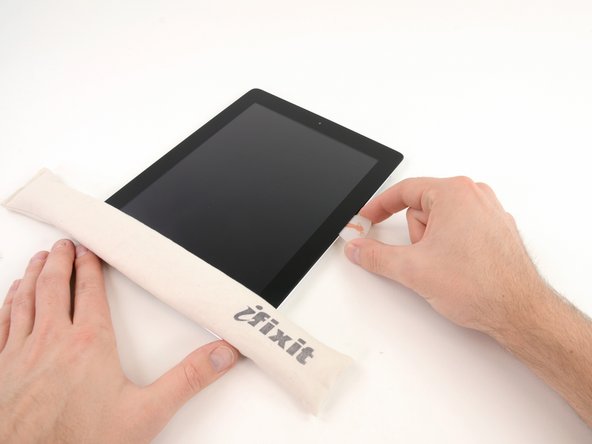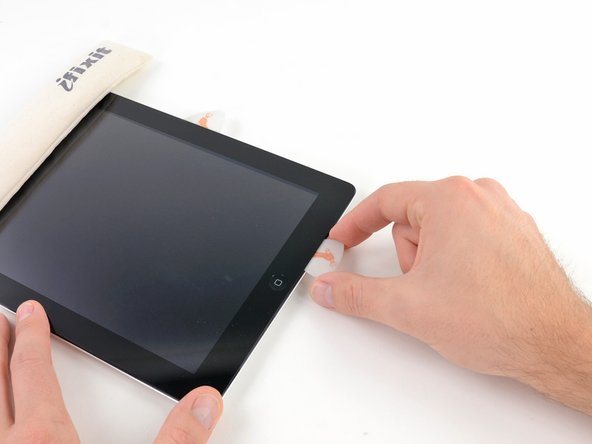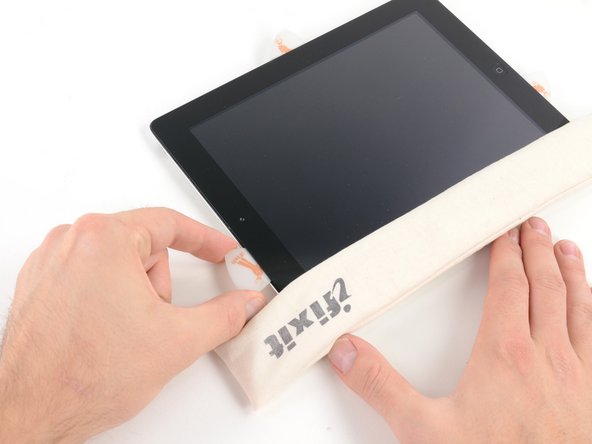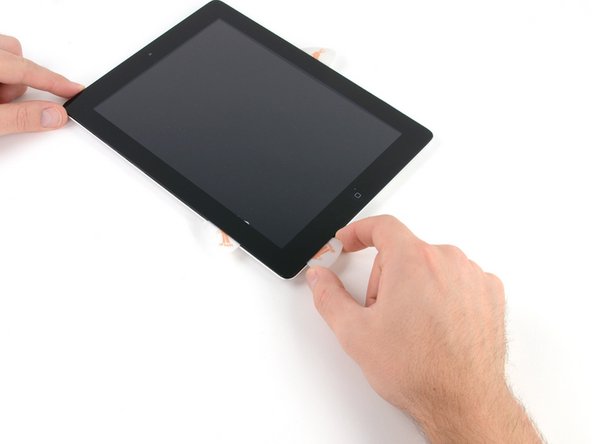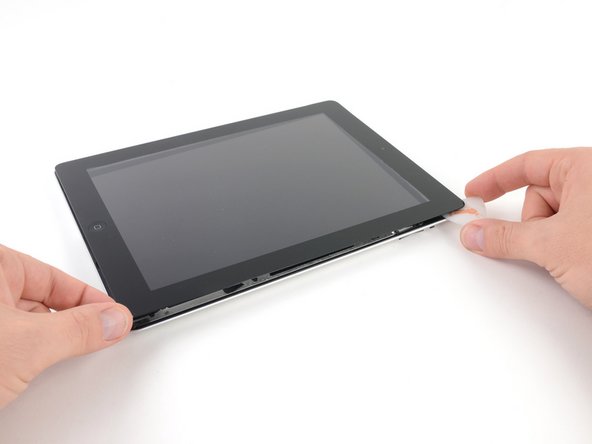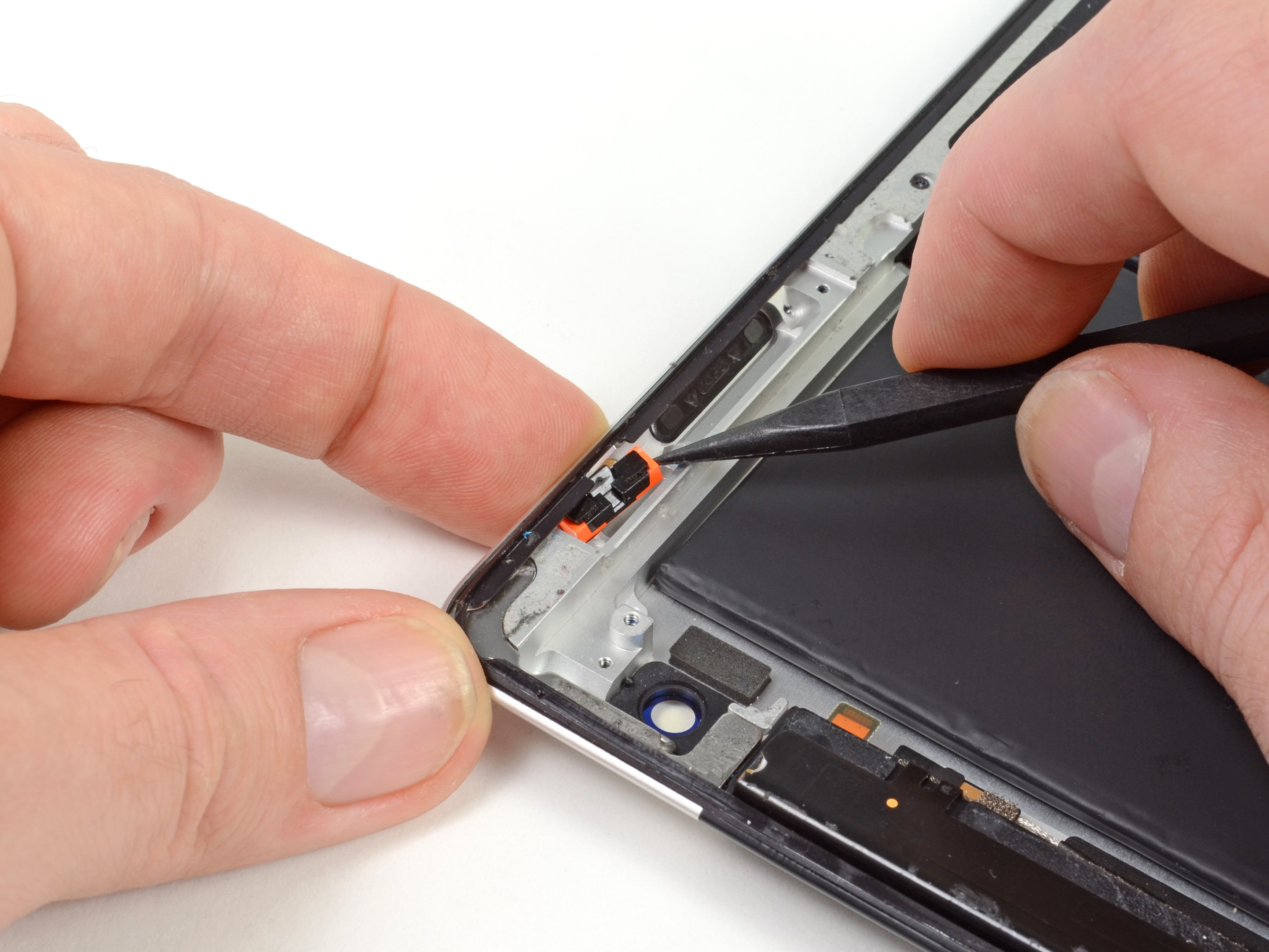iPad 3 4G Home Button Control Board Replacement
Duration: 45 minutes
Steps: 39 Steps
Ready to give that home button a fresh start? This guide will walk you through swapping out the control board like a pro. Let’s get your device feeling brand new again, step by step! And if you get stuck or need a hand, don’t hesitate to schedule a repair.
Step 1
For carousel microwaves: Double-check that the plate spins without any hiccups. If your iOpener gets stuck, it might overheat and cause a burn, so keep it moving!
Give your microwave a quick once-over before you start—no one wants gooey gunk sticking to the iOpener when it’s heating up!
- Place the iOpener in the middle of your microwave. Give it a cozy spot to warm up and work its magic.
Tools Used
Step 2
Heads up! Don't crank up the heat on the iOpener too much—overheating can make it pop like a balloon. Keep it below 100˚C (212˚F) to stay safe.
If the iOpener looks puffy or swollen, step away and don’t touch it.
If the middle of the iOpener is still too toasty to handle, keep using it while it cools down a bit before heating it again. When warmed just right, it should stay nice and cozy for around 10 minutes.
Microwaves come in all shapes and sizes, so heating times might vary. Your iOpener is ready when it’s just a tad too warm to keep your fingers on it comfortably.
- Warm up the iOpener in the microwave for about thirty seconds to get it ready.
- As you go through the repair, if the iOpener cools down, just pop it back in the microwave for another thirty seconds to keep it nice and warm.
Tools Used
Step 3
Heads up! The iOpener is going to be pretty hot, so be careful when handling it. You might want to grab an oven mitt to avoid any accidental burns.
- Carefully take the iOpener out of the microwave, holding it by one of the two flat ends. This way, you can avoid touching the hot center and make sure everything stays cool.
Tools Used
Step 4
Heads up! The iOpener gets seriously hot, so make sure to grab it only by the end tabs to keep your fingers safe.
If you don't have a microwave, no worries! Just follow this step and warm up your iOpener using boiling water.
- Grab a pot or pan and fill it with enough water to completely cover your iOpener.
- Bring the water to a boil, then turn off the heat—no need to keep it bubbling.
- Gently dunk your iOpener into the hot water and let it soak for 2-3 minutes, making sure it’s fully submerged.
- Carefully fish out the warm iOpener using tongs—hot hands are no fun!
- Give it a good towel dry so it’s ready to go without any drips.
- Your iOpener is all warmed up and ready for action! If it cools off before you’re done, just repeat the boiling water step to heat it up again.
Tools Used
Step 5
Put on your safety glasses to keep those peepers safe, and handle the LCD screen gently to avoid any unwanted oops moments.
This will help keep any glass fragments in check and give your display the stability it needs when you're prying and lifting it up. A little safety goes a long way!
- If your display glass is cracked, keep the shards in check and avoid any ouch moments by taping up the glass first.
- Cover the iPad's screen with overlapping strips of clear packing tape until the entire front is sealed up.
- Follow the rest of the guide as best you can. Just a heads up: once the glass is broken, it might keep cracking as you work, so you may need to carefully use a metal prying tool to scoop out the glass pieces.
Step 6
Heads up! Since you might be handling broken glass here, it’s a smart move to slip on some safety glasses to keep those sneaky shards from causing trouble.
- Place the iOpener on the right edge of your iPad, making sure it lies flat and covers the surface nicely for optimal heat contact.
- Let the iOpener sit there for about 90 seconds to warm things up before you try to open the front panel.
Tools Used
Step 7
Getting that opening tool’s tip wedged between the glass and plastic might take a bit of muscle. Stay cool and patient—gently wiggle the plastic opening tool back and forth until it slips in nicely.
- Check out the tiny gap in the iPad's adhesive ring at the upper right corner, about 2.0 inches (~5 cm) down from the top. This little spot is your secret entry point.
- Line up your plastic opening tool with the mute button. Gently slip just the tip of the tool into the crack between the front glass and the plastic bezel—just enough to give that gap a little wiggle room.
Step 8
- Make sure to slide the tool carefully between the plastic bezel and the front panel glass. A little finesse goes a long way here.
Step 9
- Keep the tip of your plastic opening tool snug between the front glass and plastic bezel, then slide a plastic opening pick right next to it in the gap to gently work your way around.
Step 10
- Take the plastic opening tool off the iPad, then gently slide the opening pick under the front glass, going in about half an inch. Keep it steady and make sure you don't rush—it'll make the next steps much easier!
Step 11
- While you're loosening the adhesive on the right side of the iPad, go ahead and warm up the iOpener again, then pop it back onto the bottom edge to keep things cozy.
Tools Used
Step 12
This adhesive is seriously tough stuff—expect to flex those muscles a bit. Take your time and stay steady!
If you spot the tip of your opening pick peeking out from under the front glass, gently pull it back just a bit. Going this deep with the pick won’t cause damage, but it might leave some sticky adhesive smudges on the LCD.
- While the bottom edge is getting a warm hug from the iOpener, start working on releasing the adhesive from the right edge of your iPad.
- Slide the opening pick down the edge of your iPad, gently loosening the adhesive as you go. Take your time, you're doing great!
Tools Used
Step 13
If you're finding that the adhesive just won't let go, it might be helpful to move the heated iOpener back onto the right edge of the iPad as you release the sticky stuff. The timing of this depends on how long the iPad has been cooling down while you were busy with other steps.
- If the opening pick gets stuck in the adhesive, gently roll it along the edge of the iPad to keep loosening that sticky stuff without any fuss.
Tools Used
Step 14
- Before you take out that first opening pick from the bottom corner of the iPad, slide a second pick under the right edge of the front glass to keep the adhesive from sticking back together.
- Heat up the iOpener again, then move it over to the top edge of the iPad to keep things nice and warm.
Tools Used
Step 15
The Wi-Fi antenna hangs out on the bottom right edge of your iPad's rear case, secured by screws and a cable. Handle with care! One wrong move and this little guy could get seriously hurt. Take it slow and steady.
- Heads up: the next steps need you to be extra careful.
- You’ll need to gently loosen the adhesive holding the antenna to the front panel without messing up the delicate connections attaching the antenna to the bottom of the iPad. Take it slow and follow these steps closely.
Step 16
Keep the pick from sliding past the bottom right corner—going further might send your Wi-Fi antenna on an unexpected adventure!
- Gently slide the opening pick around the bottom right corner of the iPad to loosen the adhesive and get things moving.
Step 17
Slide the opening pick carefully along the bottom right edge of the front panel. Watch out for the Wi-Fi antenna near the corner—it's easy to nick if you’re not gentle with the adhesive!
Keep the pick tucked just a smidge under the front glass—about 1/8" (3 mm) of the tip should stay cozy underneath instead of pulling it all the way out.
- Gently slide the opening pick along the bottom edge of your iPad, releasing the adhesive near the Wi-Fi antenna. It’s a bit of a delicate dance, but nothing you can’t handle!
Step 18
- Alright, you're almost there! Once you've moved past the Wi-Fi antenna (it's about 3 inches or 75 mm from the right edge, right near the home button), slide the opening pick back in to its full depth.
- Now, gently slide the pick to the right, and you'll feel the adhesive release, freeing up the Wi-Fi antenna from the front glass.
- The antenna is connected to the bottom of the iPad by screws and a cable. By detaching it here, you make sure the antenna stays safe and sound when you remove the front panel. No need to worry about damaging it!
Step 19
Keep your iOpener chill by heating it for no more than a minute at a time, then give it a solid two-minute break before firing it up again.
If the adhesive's cooled down too much along the bottom edge, just give your iOpener another warm-up to get that adhesive nice and cozy again before you continue.
- Keep sliding the opening pick along the bottom edge of the iPad, carefully pulling it out enough to curve around the home button, then pop it back in about half an inch (10 mm) once you’re past the button.
Tools Used
Step 20
When working on iPad 4 models, slide your pick in no more than 1/2 inch (10 mm) here to keep that home button ribbon cable safe and sound.
- Keep peeling the adhesive carefully along the entire bottom edge of the iPad.
- Leave the opening pick tucked under the front glass close to the home button to hold your progress.
Step 21
- Pop the iOpener back in the microwave to warm it up, then place it on the left edge of your iPad to gently heat up the adhesive in that area.
Tools Used
Step 22
If the adhesive has chilled out too much, pop the iOpener back along the top edge and keep at it. If the iOpener itself has cooled off, just give it a quick reheat and you’re good to go.
- Gently slide the opening pick along the top edge of your iPad, nudging it out just enough to get around the front-facing camera bracket.
- The adhesive here is pretty thick, so you might need to apply a little extra muscle. Take your time and be cautious – you don’t want to slip and hurt yourself or your iPad.
- If the pick is sticking to the adhesive, try 'rolling' it as shown in step 9 to ease the process.
Tools Used
Step 23
If the adhesive feels nice and toasty, go ahead and take the iOpener off the iPad to make things easier. But if it’s still holding on tight, just warm the iOpener back up and rest it on the left edge while you keep working your magic.
- Keep peeling back the adhesive along the top edge of the iPad, then slide your opening pick smoothly around the top left corner like a pro.
Tools Used
Step 24
The digitizer cable hides out about 2" (50 mm) up from the bottom of the iPad. Stop sliding your pick once you hit roughly 2.25" (60 mm) from the bottom—no need to go further!
- Gently slide the opening pick along the left edge of the iPad to loosen the adhesive bit by bit. Heads up: the adhesive here is pretty thin because of the digitizer running along the whole left side. Keep that pick shallow—no more than 10 mm (about 1/2 inch)—to avoid any accidental digitizer damage.
Step 25
Heads up! The bottom of the digitizer cable is just about an inch (25 mm) from the iPad's bottom edge. Take it slow and steady to avoid cutting this little guy.
- With the opening pick still tucked underneath the bottom edge of your iPad, gently work it along the bottom left corner to peel back the adhesive. Nice and easy, you got this!
Step 26
Sometimes, the adhesive around the edge of your iPad may decide to stick down again. If that happens, simply slide a pick under the glass where it's still holding on and gently slice through the adhesive to free it up.
- Grab one of those trusty opening picks and gently wedge it under the bottom right corner of the iPad, then lift and grab it with your fingers.
Step 27
Watch out for any stubborn adhesive still hanging on, and use your opening pick to carefully slice through any glue keeping the front panel stuck down.
- Grab the iPad by the top and bottom right corners, and gently rotate the front glass away from the device. No rush here, take it slow.
- Before you seal it all back up, give that LCD a little TLC. Use a microfiber cloth and a puff of compressed air to make sure it’s free of dust and fingerprints. That’ll make the glass installation much smoother!
Step 28
- Unscrew the four 2 mm Phillips #00 screws holding the LCD to the aluminum frame.
Step 29
Handle the LCD with care—its ribbon cable is delicate and can snap if you bend it too much. Keep it chill!
- Grab your trusty plastic opening tool or spudger and gently lift the right edge of the LCD out of the iPad.
- Once you've got the edge lifted, rotate the LCD along its left edge and carefully place it down on top of the front panel.
Tools Used
Step 30
- Grab your trusty spudger and gently lift up the tape covering the LCD ribbon cable connector. Keep it steady, you're almost there!
Tools Used
Step 31
- Lift up the retaining flap on the LCD ribbon cable ZIF connector, just like you're opening a little door.
- Gently pull the LCD ribbon cable from its socket on the logic board using your fingers or a pair of tweezers. No need to yank—slow and steady wins the race.
- If the LCD screen doesn’t power up after you reconnect the ZIF connector, try a quick reboot by holding down both the power and home buttons for about ten seconds until you see the Apple logo. It might just need a little nudge to get going.
Step 32
- Gently lift the LCD away from the front panel, making sure not to touch the screen. Take your time, you've got this!
Step 33
- Gently lift the tape holding the touchscreen ribbon cable to the logic board using the tip of a spudger. Take it slow and steady!
Tools Used
Step 34
- Gently lift the little flap on both touchscreen ribbon cable ZIF connectors to unlock them.
Step 35
- Gently work the flat end of your spudger under the digitizer ribbon cable to carefully break up the adhesive holding it down.
- Once loosened, pull the digitizer ribbon cable straight out from its connection points on the logic board with a steady hand.
Tools Used
Step 36
- Gently peel back the touchscreen ribbon cable and use the flat end of a spudger to carefully lift the adhesive holding the cable in place on the rear aluminum case.
Tools Used
Step 37
- Gently use your fingers to wiggle the touchscreen ribbon cable free from its snug spot in the aluminum frame.
- Carefully lift the front panel off the iPad.
Step 38
- Unscrew the two 2.1 mm Phillips #00 screws that are holding the home button control board firmly in place on the home button assembly.
Step 39
- To put your device back together, just follow these steps backward. Easy peasy! If you hit a snag, remember you can always schedule a repair with us.
























